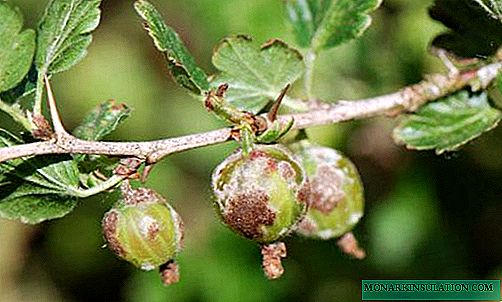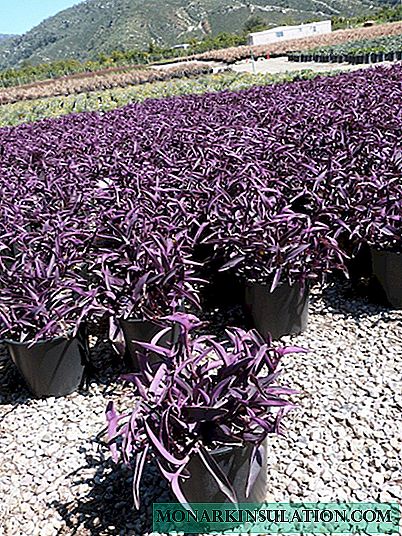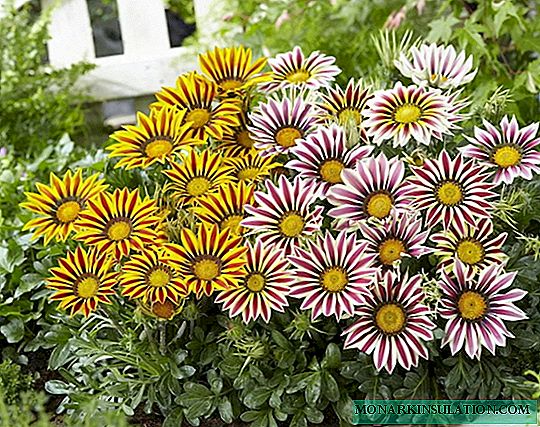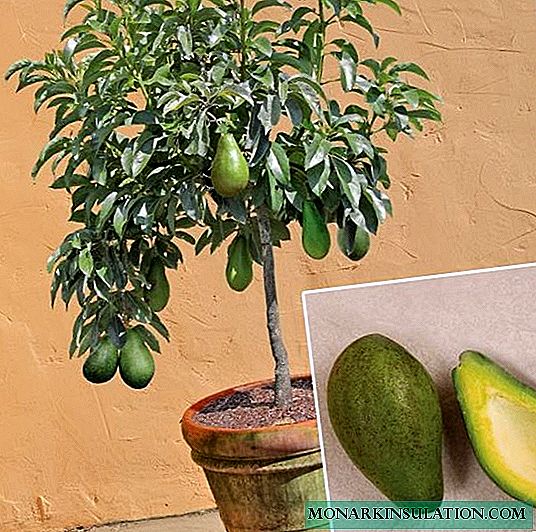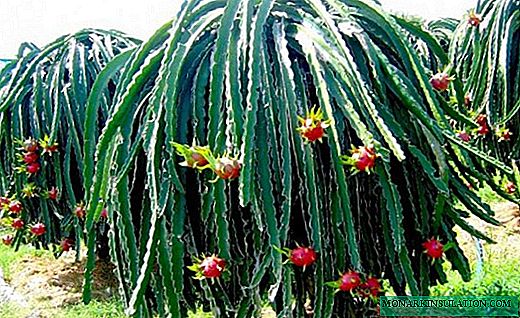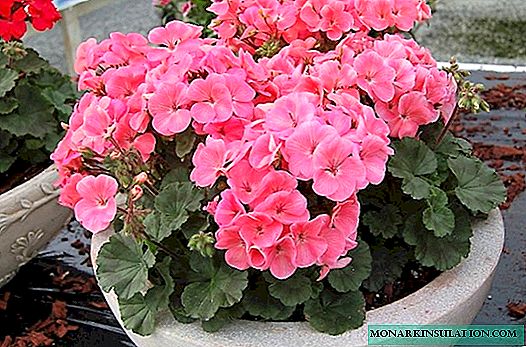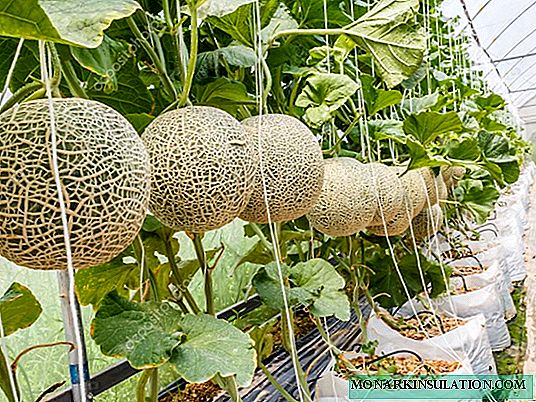
One hundred years ago, it was hard to imagine that heat-loving melons could grow in harsh Siberia. But progress does not stand still. Thanks to modern materials and technologies, new adapted varieties and, of course, the inexhaustible enthusiasm of Siberians, the fairy tale becomes true.
The best varieties of melon for Siberia
Siberia has a vast territory with different climatic conditions. Therefore, it is impossible to give general recommendations on melon cultivation for all its regions, although in general these territories have some common climatic features: the prevalence of northerly winds, short summers and changeable, unpredictable weather. In this regard, in most of Siberia, melon can be grown in open ground, but not always. If the summer is cold and rainy, there will be no harvest. Growing melons in a greenhouse, subject to the rules of agricultural technology of culture, will certainly please the result. To a large extent, success depends on the right variety.
Varieties for open ground
Due to the short summer, varieties of early (60-75 days from the time of full germination to the onset of mature maturity), medium early (65-85 days) and mid-ripening (75-95 days) ripening periods are selected.
Collective farmer
Traditionally, the well-known Kolkhoznitsa is grown in Siberia (the full name is Kolkhoznitsa 749/753). From seedlings to ripening, 77-95 days pass, depending on weather conditions. This is a long-stemmed plant with a thin stem. Fruits are spherical, medium-sized, average weight - 0.7-1.3 kg. Usually the surface is smooth, yellow-orange, without a pattern, but sometimes a coarse mesh is found. The bark is hard, flexible, medium thickness. The pulp is juicy, sweet, fibrous, semi-crisp. Productivity 1,5-2,2 kg / m2. The collective farmer is prone to severe damage by powdery mildew and anthracnosis, relatively resistant to bacteriosis. It has good transportability, and therefore is popular with farmers.

Melon collective farmer has long been grown in Siberia
Altai
The variety was obtained in Barnaul in 1937 and entered into the State Register of Breeding Achievements in 1955. The berries are similar to the collective farmer in size and appearance, only the shape is more elongated and the dimensions are slightly larger - 0.8-1.6 kg. The taste is satisfactory, "for everybody." Keeping speed and portability low. The variety is grown for personal use in areas with a short summer. The period from the first shoots to ripening is only 65-75 days. Harvest from 1 m2 - 2.5 kg.

Altai melon bred in Siberia
Tender
This melon was bred at the Federal Scientific Center for Vegetable Production in 2004 specifically for Siberia. The ripening period is 67-69 days from the appearance of seedlings. It has small (0.8-1.1 kg) light yellow berries. The shape of the fetus is oval, segmented. Light green pulp has a delicate, juicy, fine-grained structure and excellent taste. Productivity 80-142 kg / ha.

Melon Tender has a light green juicy pulp
Varieties for the greenhouse
Many hybrids have been created for growing melons in the greenhouse, although there are varieties.
Sunny
Early ripening hydride of domestic selection, bred specifically for growing in greenhouses. Gives almost one-dimensional berries with an average weight of 2.1-2.7 kg. The fruit is widely elliptical in shape with a smooth yellow bark. Drawing in the form of small and medium yellow dots. The pulp is friable, tender and juicy. The taste is great. From 1 m2 5.1-5.7 kg of fruits are obtained in the greenhouse.

Melon Solnechnaya - early ripening hydride of domestic selection, bred specifically for growing in greenhouses
Moon
Barnaul variety for cultivation in garden plots, farms in film greenhouses. Removable maturity occurs 74-80 days after emergence. The fruit is small (1.1 kg), oval, smooth. It has a continuous, connected, delicate grid. The color of the thin bendable bark is yellow. The pulp is of medium thickness, granular, slightly succulent. The taste is good, slightly sweet. Harvest from 1 m2 - 8.1 kg. The variety has good commercial qualities, transportability. It has a comparative resistance to stem ascochitosis.

Melon Moon has a smooth yellow bark
Assol
Barnaul mid-season hybrid for film greenhouses. Fruits are removed after 80-90 days after the appearance of full seedlings. The berry is oval-round, segmented, yellow with creamy gray stripes. The bark is thin, folding. The flesh of light green color has an average thickness, delicate, juicy, granular structure and excellent sweet taste. Fruits are one-dimensional with an average weight of about 1 kg. Productivity - 6.6 kg / m2. Commercial quality is high. To stem ascochitosis resistance is average.

The melon Assol flesh is light green
Growing conditions
For the successful cultivation of melon, it is necessary to create favorable conditions for it.
- The ideal temperature for melon is in the range of 20-25 ° C. At temperatures above 30 ° C and below 15 ° C, growth stops.
- Melon grows well on loose fertile soils. Heavy clay soils require loosening by adding sand, peat.
- The soil reaction should be neutral or slightly acidic, the pH level of 6.0-6.8 is optimal.
- Among the predecessors and neighbors should not be:
- pumpkin;
- cucumbers
- potatoes;
- parsley.
- The best predecessors will be:
- bow;
- turnip;
- cabbage;
- beet;
- beans;
- radish.
- It is advisable that the melon is located on the southern slope, protected from the cold northerly winds.
- Melon tolerates drought better than waterlogging.
Growing seedlings
Of course, the seedling method for growing melons has clear and undeniable advantages over sowing seeds directly into the ground. It:
- earlier harvesting;
- the ability to protect the young plant from weeds;
- lack of problems associated with germination of seeds. They are solved at the stage of growing seedlings;
- the possibility of growing later varieties of melon in the conditions of a short Siberian summer.
The disadvantages of this method include:
- the need for additional material and labor costs associated with growing seedlings;
- poor adaptation of melon to new conditions during transplantation. But this is overcome by the use of peat pots for growing seedlings.
When to plant for seedlings
The optimum age of melon seedlings for planting in open ground or a greenhouse is 35 days. Shoots usually appear 5 days after sowing. Total: sow seeds for seedlings 40 days before the intended planting on the beds. Thus, it is easy to calculate that the best time for sowing melon seeds for seedlings in Siberia is April 10-30.
How to sow melon seeds for seedlings
To plant melon seeds for seedlings, you need to prepare peat pots with a volume of 150-200 ml and fill them with nutritious soil. You can buy it in the store - nowadays there is a wide selection of ready-made soils. It is possible to independently prepare the soil in the fall, mixing in equal proportions the turf land, peat, humus and sand. On a bucket of such a mixture you need to add 1 tbsp. l superphosphate, 1 tsp potassium monophosphate (it is added immediately before planting), 1 tbsp. wood ash and 1 tsp. urea.
Seeds are sown in 3 pieces in one pot to a depth of 2-3 cm. Pre-germinated seeds can be sown one at a time. The soil must be well moistened before sowing. Before emergence, the pots are in a room with a temperature of 25-28 ° C, after which the temperature is reduced to 20-25 ° C.

Melon seeds are sown in 3 pieces per hole
Seedling Care
During seedling growth, the soil is periodically moderately irrigated with warm water. Melon does not like dampness and waterlogging. After the appearance of the third real leaf, thinning is carried out - all weak sprouts are removed, leaving one strong in each pot. At the same time, pinch the plant over the third leaf so that it grows in breadth, and not in height.
10 days after germination and 10 days before planting in the soil, seedlings should be fed with potassium humate. To do this, 10 ml of fertilizer is dissolved in 1 liter of water, 50 ml of solution is poured under each plant. And also 10 days before transplanting seedlings, it should begin to harden. To do this, pots with plants are taken out to the balcony or to the yard. The procedure begins with 3-4 hours, then gradually increase the duration to a day.
By the end of the period, the plants can already be left on the balcony at night, if the temperature allows. Daytime air temperature for hardening should be between 15-17 ° C, and nighttime - 12-15 ° C.

Melon seedlings are best grown in peat glasses.
Transplanting seedlings into the ground - step by step instructions
The melon bed is prepared in 2-4 weeks, and preferably in the fall. First weeds are removed, spread evenly on the surface of the fertilizer:
- 5-10 kg / m2 humus, compost or peat,
- 30-40 g / m2 superphosphate and ammonium nitrate,
- 10-20 g / m2 potassium monophosphate,
- 1 l / m2 wood ash.
The bed is well digged and leveled with a rake or cultivator. The following acts as follows:
- 2 weeks before planting, the bed is covered with a black film - this way the earth will warm up well.
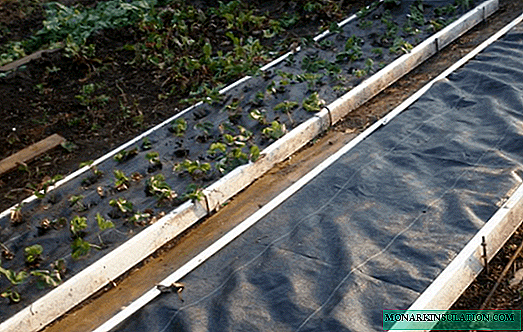
2 weeks before planting, the bed is covered with a black film so that the earth warms up
- Before landing, make markings. The distance between the rows should be 70-90 cm, and between the plants in the row - 60-70 cm.
- A hole with a diameter of 20-30 cm is prepared for each plant, to which 0.5 ml of humus is added, mixed and watered.
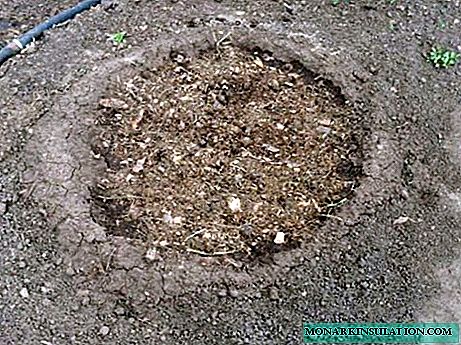
Wells are prepared for planting melons
- Seedlings are planted in prepared holes along with peat pots, watered and sprinkled with dry earth.
- Arcs are installed along the bed and covered with agrofiber with a density of 30-60 g / m2.
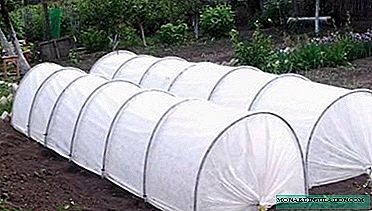
Arcs are set along the bed and covered with agrofiber
Planting seeds
For various reasons, the gardener may prefer a seedling method of growing melons. Under certain conditions, this can be done in Siberia.
In open ground
In Siberia, the method of growing various crops on warm beds is widespread. For its arrangement, the upper layer of the earth with a thickness of about 20-30 cm is removed and the resulting pit is filled with organic waste, half-ripened compost, humus. Around the perimeter set a fence of boards, flat slate. Fill the volume with chernozem taken out before it. Overbearing, organics will warm the roots of plants. Arcs are installed along the bed, along which the film or covering material will be stretched.

Arcs or a wooden frame is installed above a warm bed
The sowing period is calculated according to the above algorithm. Wells are marked and prepared for planting in the same way as with the seedling method of cultivation. In each hole to a depth of 2-3 cm, 3 seeds are sown, watered and covered with a black film. It is harvested after seed germination and is covered with agrofibre bed in arcs. Further actions with sprouts are the same as with seedlings. After the third real leaf they pinch, the extra sprouts are removed.
To the greenhouse
Planting seeds in a polycarbonate greenhouse is no different from the one just described. The difference is only in terms - seeds can be planted in a greenhouse 2-3 weeks earlier than under shelter.
Melon Care
Spring and early summers in Siberia are distinguished by the contrast of day and night temperatures, the difference of which can be more than 20 ° C.
In the open ground
In such conditions, often young plants require additional night warming. To do this, use plastic bottles with a cut neck, cardboard boxes. An additional layer of agrofibre can also be laid along arcs. From around mid-June, shelters will no longer be needed.

In the spring, when frost occurs, melon seedlings can be covered with cardboard boxes
Watering
Regular and frequent watering of melons is needed at the stage of growth of young plants. At this time, the soil should always be moist. To preserve moisture, the beds are mulched with hay, rotted sawdust, humus. A great option is to cover the beds before sowing with black film. In this case, the seeds are sown in the cut holes, and further loosening and weeding will not be required. Watering in this case is also simplified. In addition, under a black film, the earth warms up better, and the heat is stored in it even on cold nights. When the bushes grow up - the number of irrigations is reduced to once every 7-10 days. It is convenient to water melons using drip irrigation systems. Irrigation is completely stopped when the fruit has grown and begins to turn yellow.
If, because of the rainy summer, the beds with melons are too waterlogged, you may need to sometimes cover them with a film in arcs to protect them from rain. In this case, the ends of the tunnel are left open.

It is convenient to water melons using a drip irrigation system
Top dressing
A well-tilled bed usually contains enough fertilizer. But if the bushes do not grow well, you should feed them nitrogen. It is best to use liquid forms of organics. In a warm place for a week insist in the water mullein (3 liters per bucket of water) or chicken droppings (it is taken half as much). The resulting fertilizer is diluted with water about 5-7 times and feed melons. Repeat such feeding 2-3 times with an interval of 7-10 days. During the period of growth and ripening of fruits, you can use infusion of wood ash (2 liters per bucket of water). In addition, suitable complex fertilizers for gourds. They are sold under the trademarks Net Leaf, Sudarushka, Agricola and others.
Formation and normalization
Before the formation of melon, you should know that in varietal plants, fruits are formed on the side shoots, in hybrids - on the main stem. In open ground, varietal melons are more often planted and form them into 2-3 stems. Each stem is pinched over the fifth leaf and laid out evenly on the surface of the beds. From the sinuses of the remaining leaves, lateral shoots grow on which flowers bloom. Depending on the variety, from one to five fruits are left on each stem. The more melons you leave, the smaller they will be. If normalization is not carried out at all, then too many fruits can be tied, they will be small and will not ripen. Each fruit-bearing shoot is pinched behind the fifth leaf growing after the fruit.
Trimming and pruning
In the process of growth, you should carefully monitor the formation of stepsons in the axils of the leaves and periodically remove them. Lateral shoots are also cut off, on which no ovaries have formed. These parts of the plant, which are not involved in fruiting, take on part of the nutrition, thereby reducing the size and weight of the fruit.
Green melon care
Caring for a melon in a greenhouse has its own characteristics. The first is associated with the formation of the plant. Since hybrids are usually planted in the greenhouse, where the fruiting is on the stem, all side shoots are removed. Usually one or two shoots are left, which are tied vertically to the trellis. The fruits are placed in spacious nets that are suspended so that the melons do not break off under their own weight.
The second feature is that the bees do not get into the greenhouse, so the gardener has to take on their role. Artificial pollination is usually carried out in the morning. To do this, use a soft brush, which collect pollen from male flowers and transfer it to female. You can distinguish female flowers by the presence of thickening in their lower part - this is the future ovary of the fetus.
You can do without a brush. They tear off a male flower, carefully tear off the petals from it, so as not to shake off the pollen. Then, touching the male flower to the stigma of the female, they fertilize it. This should be done with a margin - subsequently, from the formed ovaries, it will be possible to choose the best, and remove the rest.

In the greenhouse you have to work as a "bee"
The third feature of growing melons in a greenhouse is the need for regular ventilation on hot days. All other rules and care methods are the same as when growing in open field.
Video: shaping and caring for a melon in a greenhouse
Diseases and Pests
So that the works on melon cultivation in Siberia do not go down the drain, you should know the signs of the main diseases and pests, as well as methods of prevention and control.
The main diseases that affect melon in Siberia
The main diseases of melon are usually fungal. Therefore, methods of treatment and prevention are often similar and are common to various diseases.
To combat fungal diseases, as well as to prevent them, drugs called fungicides are used.
Powdery mildew
Numerous whitish spots appear on the leaf plate. Growing, they cover the entire sheet, which consequently becomes brittle, brittle and completely dries out. Disease prevention is crop rotation and timely weed removal. As a treatment, pollination of plantings with 80% sulfur powder helps at the rate of about 400 g per hundred square meters. Three treatments with an interval of 10 days are enough. They need to be completed 20 days before the harvest. The most effective means of controlling powdery mildew is Topaz. It not only stops the development of the disease, but also blocks its spread, since it destroys spores. This drug is great for Siberia, since it can be used at low temperatures. For 10 l of water, it is enough to add 2 ml of fungicide.

Powdery mildew covers leaves with whitish spots
Peronosporosis (downy mildew)
A common ailment with which a plant most often gets sick in the early stages of development. First, yellow-green spots appear on the leaves, increasing with time. Later, spores of the fungus accumulate on the underside in the form of a purple coating.
For prophylaxis purposes, presowing disinfection of seed material by dressing in a 1% potassium permanganate solution is recommended. You can also conduct heat treatment of seeds, keeping them for 2 hours in a thermos with hot water at a temperature of 45 ° C. The planted seedlings or young plants that emerged from the seeds during the non-seedling method of cultivation are sprayed with a 0.1% solution of urea or a 1% solution of Bordeaux liquid. You can also handle Topaz.
Cucumber mosaic
This is a viral disease that is transmitted by the melon aphid, and viruses accumulate on the roots of weeds. Signs of the disease:
- yellow-green spots on the leaves,
- their deformation and the formation of tubercles between the veins,
- falling of leaves and flowers,
- cracks at the base of the stem,
- growth retardation
- warty surface of the fruit.
Prevention measures: crop rotation, melon aphid control. There are no ways to combat an already appeared disease. You can only pick off the affected leaves and shoots, thus slowing down the spread of the disease and save part of the crop. After harvesting, all the tops and roots should be burned, and on this site in the next 3 years to plant crops that are not subject to cucumber mosaic.
Gray mold
This disease is often observed in Siberia, as it develops in cold, wet weather. The optimum temperature for it is 15 ° C. Affected young shoots and ovaries become watery, quickly moldy. If detected, they are removed and destroyed, and weeds are regularly and thoroughly cleaned. Melons are watered through grooves or using drip irrigation systems; sprinkling is not used.

Young shoots and ovaries affected by gray mold become watery
For processing using a solution of:
- water - 10 l
- zinc sulfate - 1 g,
- urea - 10 g
- copper sulfate - 2 g.
Root rot
In unfavorable temperature and soil conditions, plants weaken and can get root rot. Its causative agent is in the soil, occasionally in the seeds. Often appears in greenhouses when the optimal temperature and humidity parameters are not observed. Affected seedling stems thin out, turn brown, and plants die. On adult lashes, the leaves begin to turn yellow and wither, the roots turn brown, the stems are macerated. The disease can be prevented by pre-sowing seed disinfection, strictly observing the rules of agricultural technology and the parameters of the heat and humidity regime.
Melon Pests
There are a number of insects in Siberia that love to enjoy the fruits and leaves of melon. To combat them, insecticides and acaricides are used.
Insecticides are insecticides, acaricides are ticks.
Gourd aphids
This small insect hibernates on the roots of weeds. Distributed in areas of Western Siberia. In the spring, when the air temperature rises to 12 ° C, the aphid creeps out and begins to feed on weeds, then switches to cultivated plants. Colonies of insects populate the lower surface of the leaves, feed on their juice, and also affect flowers and shoots.
Aphids carry various infections, including cucumber mosaics.

Gourd aphid colonies settle on melon leaves, stems and flowers
To combat harmful insects in cold weather, Decis is used, which will effectively and quickly (in 10-12 hours) destroy aphids. For spraying, 0.35-0.5 g of the drug is dissolved in 5 l of water. This amount is enough to handle 100 m2 beds. In hot weather, Fitoverm is used - it will take 72 hours to completely defeat the pest. For treatment, 1 ml of water is taken with 2 ml of the drug. In addition, there are many folk remedies for combating this well-known pest.
Melon fly
Melon fly can infect melons in Siberian regions bordering Kazakhstan. The flight period is extended and lasts about a month. Female flies lay eggs under the skin of melons, where in 3-4 days larvae appear. They immediately penetrate the pulp and begin to feed on it, making numerous winding passages. Larvae have a length of 5-10 mm, a lifespan of 10 days. Affected fruits rot, unsuitable for food. Detection of melon fly can be detected by the presence of small holes on the surface of the fetus through which the larvae penetrated inside.

You can detect a melon fly lesion by the presence of small holes on the surface of the fetus
For prophylaxis, deep autumn plowing is carried out (deep digging of the soil in late autumn), presowing seed dressing, early ripe varieties are used. An effective measure is the protection of plantings with light covering material (spanbond, lutrasil, etc.) with a density of 17 g / m2 for the flight period of the fly.
Preventive treatments with insecticides such as Decis, Fufanon, Fitoverm, Iskra-Bio are effective. They are used during the flight of the flies with an interval of 10-15 days. Solutions are prepared according to the instructions for use.
Spider mite
In closed ground conditions, the spider mite feels best, although it is common everywhere. Dry, hot summers are especially favorable for him. Settles on leaves (on both sides), stems and fruits (with massive damage). Damaged plants acquire a pale yellow color, a thin web appears in the internodes of the stems and between adjacent leaves. The leaves discolor and die, the stems are exposed, fruiting is reduced.

In internodes and between leaves, a spider mite weaves a thin, transparent web
In order to prevent in the greenhouses, the topsoil is replaced, fumigated, and regular treatment with acaricides. You can recommend Karbofos, Actellik, Apollo. These funds should be alternated, as they are addictive.
Harvesting and storage
For laying melon fruit for storage, it is important to correctly determine the desired degree of maturity. Berries with a slightly expressed net are immature and have not been reached in the process of storing ripeness. Fruits with a full net ripen quickly, and their shelf life will not exceed 2 months. Empirically, you should determine the "golden mean."
If the variety does not have a net, then they are guided by the degree of yellowing of the bark.
For storage suitable late-ripening melons, which in Siberia can only be obtained in the greenhouse.
When harvesting, a peduncle about 5 cm long is left for storage. Melons are sorted by size and maturity. After that, they are stacked on wooden shelves in one row. You can also hang fruits from the ceiling or beams in loose cotton nets. At a temperature of 1-3 ° C and humidity of 70-80%, melons can be stored until February and even March.

Melons for storage can be hung in nets or tied with a rope
It turns out that in our time, melon can be grown in Siberia. Of course, in different zones the growing conditions are different, but this should not stop a true enthusiast. To help gardeners - warm beds, modern insulation materials, polycarbonate greenhouses, zoned varieties.




